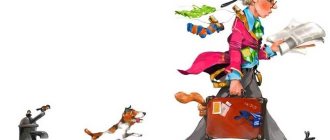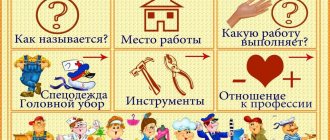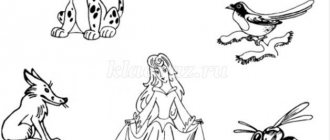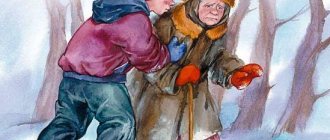Laura Nigkolova
Summary of educational activities for children of the senior group “The House and Its Parts”
Topic "House and its parts "
Tasks:
Educational area "Cognition"
• Clarify and expand children's knowledge about the house and its parts .
• Clarify and expand knowledge about the purpose of rooms in the apartment.
• Develop auditory and visual perception, memory, attention, imagination, intelligence.
• Develop spatial orientation when composing an object from shapes.
Educational field "Communication"
• Practice forming complex adjectives.
• Clarify and expand the vocabulary on the topic “House and its parts ”
.
• Activate children's speech.
• Learn to coordinate nouns with adjectives.
• Learn to form adjectives from nouns.
• Develop coherent speech.
Educational field "Socialization"
• To form a positive attitude for children to participate in the lesson , the ability to work in a team.
Educational field "Health"
• Preserve and strengthen the physical and mental health of children
Integrative qualities of children: to develop curiosity, mental and speech activity, independence, adequate use of means of communication, proficiency in dialogical speech, and the ability to manage one’s behavior.
Dictionary:
Subject: house, builder, walls, roof, windows, floor, door, balcony, entrance, apartment, elevator, staircase, hallway, bedroom, kitchen, bathroom.
High-quality: brick, stone, wood, single-story, multi-story, new, beautiful.
Verbal: build, enter, rise, sleep, cook, wash, wash.
Methods and techniques: greeting ritual, “Say kindly”, “Let’s build a house”, illustrations, conversation, summary.
Health-saving technologies: Fizminutka
Materials: Picture of a multi-story building, pictures ( parts of the house , entrance, stairs, elevator, bedroom, kitchen, bathroom, hallway, ball, envelopes with geometric shapes, doll.
Topic “House and its parts” (lesson No. 2)
Goals:
— activation of the dictionary on the topic; - practical mastery of relative adjectives; - Difficult words; - writing a simple sentence.
Equipment:
ball, pictures - houses of different heights.
Progress of the lesson
1. Organizational moment.
"We're building a house." Children stand in a circle. The child starts the game with a ball in his hands. "I will build the foundation." Passes the ball to whomever he wants. Whoever has the ball continues the game. "I will build walls" ...
2. Formation of relative adjectives.
Let's remember the fairy tale "The Three Little Pigs". “What material were the piglets’ houses made of? - Made of straw, twigs, stone. In which house did they escape from the wolf? - In stone. Why? - It is the most durable. What do people use to build strong houses for themselves? - Made of brick, wood, panels, blocks. We need to give the piglets some advice. What kind of houses are best to build to protect them from cold and wind? — I will advise building brick houses. “I will advise the piglets to build block houses (panel, wooden, stone).”
Physical education minute.
All day long, knock and knock, knocking fist against fist
There is a loud knock.
We are building a house, a big house, arms to the sides, up
And with a porch, and with a chimney,
hands at the chest, at the top
We will decorate the house,
paint
At the top we will nail a flag,
on the fingers there is a flag
They will live in that house,
put their palms to their heads, then their fists
Bunny with bear and elephant,
arms forward, palms connected
4. Formation of complex words.
“Houses differ not only in the material from which they are made, but also in height. What kind of houses are there? “Low, high, high.” The speech therapist says that she lives in a house with two floors. She lives in a two-story house. “What houses do you live in?” Children remember how many floors there are in their house and, with the help of a speech therapist, form the words: three-story, four-story, five-story...
5. Summary of the lesson.
Homework: look and count how many floors there are in your house. What material is it made of?
Topic “House and its parts” (lesson No. 3)
Goals:
- an exercise in composing a simple common sentence; - use of a preposition between
; - development of mental processes.
Equipment:
cards, a house made of building material (three floors, each with three apartments), toys.
Progress of the lesson
1. Organizational moment.
“Tell me, what house do you live in? (homework)". For example, I live in a five-story brick building.
2. Development of fine motor skills.
Exercises “Walls”, “Ceiling”, “Door Opens”, “Roof”.
3. Development of logical thinking.
“We’ll move the house.” Each child needs to fill out a card so that identical figures do not end up next to each other. They quarreled and don't want to live together. Next is the children's story. For example: “On the third floor I have a tick, a dot, and a stick. On the second floor there is a dot, a stick and a tick. And on the first one there is a stick, a tick and a dot.”
Physical education minute.
We run up the stairs and count the floors, running in place
One floor, two floors, three, four,
jumping in place
We are in the apartment.
turning around
5. Using the preposition between.
"Housewarming in a new house." Children are invited to help settle new residents in a new home. Children place three toys on each floor. Next, you need to tell who was accommodated on the first, second, third floor. But first we need to talk about the first and third apartments, and then about the second. For example: “I occupied the first floor. Dogs now live in the first apartment, and Cheburashka in the third. And between them, in the second apartment, there is Gena the crocodile, etc.”
6. Summary of the lesson.
CLOTH
Topic “Clothing” (lesson No. 1)
Goals:
— activation and expansion of the dictionary on the topic “Clothing”; - ability to ask questions independently; - mastering possessive nouns; - development of attention, memory, thought processes.
Equipment:
subject and cut-out pictures depicting clothes, dolls, doll clothes.
Progress of the lesson
1. Organizational moment:
“Let the one with the red shirt (blue shorts, green dress, white tights, etc.) sit down.”
2. Development of fine motor skills.
Exercises for fingers “Putting on gloves”: massage each finger from the nail to the base, first on one hand, then on the other, starting with the little finger.
3. Introduction to the topic.
Two dolls are displayed in front of the children - one dressed and one undressed. The speech therapist asks questions: “How are these dolls different? Why does a person need clothes? Object pictures on the topic are displayed and named. It is proposed to name the clothes that are not in the pictures. “How can we call these objects in one word? (Cloth)".
4. Development of mental processes.
Game “Remember and name in order.” Children are offered 5-6 pictures of items of clothing to memorize, then without visual support they must list them. Options:
1) Several object pictures are displayed in front of the child. The speech therapist lists them without naming one. The child must determine which of the pictures was not named.
2) The child is called one more picture than is displayed in front of him. He must determine which picture is missing.
5. Physical school.
6. Use of possessive pronouns.
The speech therapist invites children to choose from the presented subject pictures those about which we can say:
Mine is a fur coat, jacket, blouse, skirt, shirt, etc.; Mine is a sundress, suit, sweater, jacket, raincoat, etc.; Mine are pants, shorts, socks, tights, mittens, etc.; Mine - dress, coat, underwear.
7. Development of perception and spatial concepts.
Game "Add the pictures." Each child is given a cut-out picture on the topic “Clothing”. He must collect this picture and name the object depicted on it.
8.
Game "Guess what I wished for." The speech therapist takes a picture of an item of clothing without showing it to the children, and the children, using leading questions, try to guess the item of clothing. The child who guesses first becomes the leader of the game.
9. Fixing the material.
Game "Let's help Olya and Kolya." “We need to pack our things for the trip for Olya and Kolya. Here is Olin’s suitcase, and this is Colin’s suitcase.” Each child takes one item and determines whose clothes it is and whose suitcase it needs to be put in. “This dress is for Olya, Olya’s dress. This is a sweater for Kolya, Colin’s sweater.”
10. Summary of the lesson.
“What did they talk about today? What are the clothes for?
Topic “Clothing” (lesson No. 2)
Goals:
- expansion and activation of the dictionary, - practical use of the names of clothing parts; - formation of diminutive forms of nouns; — practicing phrases using nouns in the accusative case.
Equipment:
subject pictures, outline of clothing for frontal work, cut-out pictures, toy telephone.
Progress of the lesson
1. Organizational moment: formation of the plural of nouns.
The speech therapist throws the ball to the child and names the item of clothing in the singular, and the child in the plural: skirt - skirts, shirt - shirts, jacket - jackets, dress - dresses, but... trousers, shorts. Option: each child has a cut-out picture of clothes on the table. Game "Fold the picture."
2. Development of fine motor skills:
“Let’s put on gloves” (see lesson No. 1).
3.
The speech therapist calls two children to the board, and the whole group examines and names the name of the part of their clothing.
4. Fixing the material.
Game “Who can name the most pieces of clothing?” The group is divided into two teams, representatives are selected who name the details of the clothing. The rest of the children count the number of named objects.
5. Physical school: children imitate getting ready for a walk with their movements.
6. Practicing the phrase.
The speech therapist puts out a sheet of paper with a drawn outline of an item of clothing. Children take turns going to the board and finishing drawing some detail, voicing their actions, for example: “I drew a pocket, etc.”
7. Formation of the diminutive form of nouns.
The speech therapist tells the children about the magical land of Gnome, where little people live. You can call them on the phone and tell them what the details of clothing are called in ours and in theirs: “We have a collar, and you have a collar” (frill, shoulder strap, pocket, fold, etc.).
8. Summary of the lesson.
Children name the details of clothing in a chain, repeating the previous word and adding their own.
Topic “Clothing” (lesson No. 3)
Goals:
— expansion and activation of the dictionary; - practical use of relative adjectives; - use of antonyms in speech; - development of thought processes.
Equipment:
object pictures, samples of different types of fabric, the game “Atelier” - the outline of clothing for frontal work, cut-out pictures, a toy telephone.
Progress
1. Organizational moment.
Ball game “Say kindly” (name of clothing details).
2. Formation of relative adjectives.
The speech therapist says that a package has arrived with various fabrics so that we can sew beautiful clothing models for the exhibition. But first you need to repeat the names of the fabrics. For example: drape. And the conversation about fabrics follows the following pattern: “What quality fabric is this? What types of clothing is it used for? What can you sew from drape? What will this thing be called?
3. Physical education minute.
It is held in the form of a game between two teams. “Who can fasten the buttons on a doll’s clothes faster?”
4. Consolidation of new material.
Game "Atelier" (or "Exhibition"). Each child takes a piece of fabric and a suitable picture of clothing. The speech therapist asks the question: “What clothes will he make from this fabric? What will these clothes be called? You can give a sample story: “I will make a coat from drape. It will be a drape coat.”
5.
Game “Guess what clothes I have in mind?” The speech therapist hides one picture, describes it, and the children guess what is shown in this picture.
6. Summary of the lesson.
“What did we learn about in class today? What products did we make for the exhibition?” (Drape coat, cotton jacket, wool jacket, silk blouse, denim shorts, wool sundress, etc.)
Topic “Clothing” (lesson No. 4)
Goals:
— expansion and activation of the dictionary on the topic “Clothing”; - development of coherent speech, - clarification of the concepts “put on - put on.”
Equipment:
subject and subject pictures, doll, doll clothes.
Progress of the lesson
1. Organizational moment.
Children stand in a circle, the speech therapist offers to sit down for those who have something red (blue, green, black) in their clothes. Children must name the color and item of clothing.
2.
The speech therapist's conversation about how the doll Katya is going for a walk. It is necessary to help the doll get dressed, and the speech therapist offers each child the choice of putting some item of clothing on it. The child goes to the board, chooses clothes and discusses his actions: “We’ll put tights on Katya (blouse, jumper, sweater, scarf).” Generalization: we put something on (on...), we dress... (someone).
3. Fixing the material.
The demonstration canvas displays plot pictures, on one of which a girl or boy is dressed, on the other a child puts on something. The speech therapist asks: “Which pictures can we say “dress” and which ones can we say “put on”?”
4. Physical education minute:
1) Masha put on a mitten. “Oh, where am I going? My finger is missing, I’m missing, I didn’t get to my little house.” Masha took off her mitten. “Look, I found it.”
2) Children go out into a circle and sit on the rug. The speech therapist asks one child to leave the group, and the rest of the children must remember what clothes the child is wearing.
5. Development of coherent speech, composing a story based on pictures.
The speech therapist suggests coming up with a name for the doll and packing it up for a walk. He asks questions about what we will put on the doll and where it will go for walks. A story is composed of 3-4 sentences.
6.
The story is repeated by two or three children.
7. Summary of the lesson.
“What did we learn in class?” - “We learned to say words correctly.”




